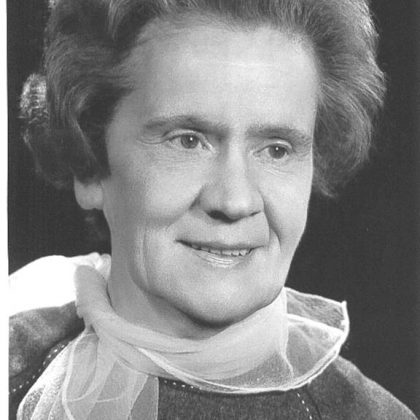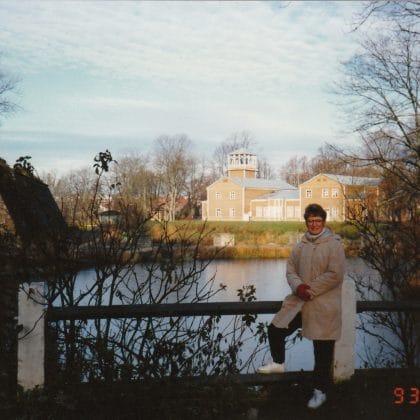Here is my mother’s story of growing up in Kuressaare. She was born in 1914 and died in 2009. She lived in Kuressaare from 1916 to 1944. The story below was written in the 1980s and continues beyond what I have sent you to also tell the story of my father, Maks, who was an Estonian too. He died in 1974. They made a life for themselves here in Adelaide, Australia. In 1993 I was able to take my wife and children to visit Saaremaa for a few days. Most of the photos below are from that trip. We visited her family home, and at that stage her brother was still alive so we also met him. Sadly he was already suffering from dementia, but we were able to have a conversation nevertheless. The house has been knocked down recently and has a new building to replace it. It’s near the “Loss”.
By the way, I was born in Australia, but I can still speak Estonian. I don’t get much of an opportunity to speak now, though. I visited Estonia again in 2012 and 2014, but did not get back to Saaremaa, sadly.
“MEMORIES GIVE BACK THE DAYS BYGONE”
With the thought of the anniversary
of Alma Mater (University of Tartu).
I, Emilia (nee BUKSIN) SOEKOV was born on 15th June 1914 in Moscow. I was christened in the Catholic Cathedral in Moscow (my father was Catholic). When I was 2 years old my father died. My mother, a widow with 6 children, had a hard time to keep us all together. In 1916, the younger ones – Joseph, Felicia and I, (Emilia), came to live with grandfather and grandmother in Kuressaare, Estonia.
Kuressaare was a health resort, people from abroad came to spend their summer vacation there. There were 3 sanatoria – institutions for healing the sick (mainly rheumatism) with mud (a special healing mud). Prof. A. Paldrock, specialist in this field, spent the summer months on practical work in Kuressaare.
I was brought up an Estonian and went to Estonian school. After completing Primary School I spent 2 years at “Karja” home-economics school, 1 year learning weaving theory and doing patterns under the guidance of Mrs. Neps, who was the wife of the Town Mayor. My confirmation took place in the Evangelical Lutheran church in Kuressaare by Pastor Mahle, on 14th May, 1931.
In my youth I was a browny and girl-guide. I was good at swimming. I used to swim out to a small island called “Lajamadala” island. On the beach I played volley-ball and I sang in the choir. I also liked to ride the bicycle and in winter skiing – on borrowed skis.
Lajamadala in 1993
A schoolmate from our street sometimes took me sailing on the frozen sea. Sailing on ice is extremely fast, frightening and exciting.
It was hard to obtain work, I did any job I could get. In the evenings I took a first-aid and Samaritan course and obtained an assistant-nurse certificate. In 1944 we were to leave Tallinn by ship, but we were late and just missed the ship. A truck load of Estonian soldiers was leaving for Kuressaare and we managed to get on the truck.
The “Loss”, or Castle in Kuresaare
At Kuressaare hospital I worked only 2 weeks, then we had to move out on boats with wounded soldiers -1 nurse to every 20 people. Home was close to hospital, so I was allowed to call, accompanied by a marine, to say goodbye to mother and get my case which was ready packed for any emergency. Mother made the sign of a cross on my forehead and said : “May God’s Grace be with you, in spring when the lilac blooms I will be waiting for you”. She meant all 3 of us – me, Fee and Nastja – they had left earlier. Mother was a strong woman, no tears; she had faith and hope. Leaving home came like a wind gust, I vanished with the October wind into the unknown, only mother’s words kept ringing in my ears for a long time.
On 6th October 1944 we left Estonia, at dusk I stepped into the boat. In the bottom of the boat lay the wounded soldiers packed very close together. I was positioned in the middle to get a view over the sick.
We journeyed all night in the dark with no hits from bombs nor torpedoes. God’s Grace was with us and on 7th October we reached the port of Liebau (Liepaja).
A soldier was told to take me to a big ship “Nordstern”, but as we were walking towards it we met Vera. She too was from our hospital. This was like a God’s sent. She had presumed me drowned with all the patients as mine had been the last boat to leave Saaremaa. Vera took me to another small ship “Lazarett Oberhausen”, there we joined other Estonian nurses – Vera, Laine, two Lydia’s – a tall and a short one.
Soon we continued the dangerous journey towards Danzig in a convoy with “Nordstern” and other ships. Then came an evening attack, our ship went zig-zaging. We were told to be ready with life belts for emergency. “Nordstern” was hit by a torpedo and sank. Other ships from the convoy saved as many loves as they could. It was a horrible tragic experience in the darkness of the night. On that ship had been a lot of wounded soldiers, civilians and Estonians.
On 8th October, 1944 after a journey of 2 days we reached Danzig. The 5 Estonians stuck together. We were later taken to Heringsdorf, where we completed in German nurses’ exams. During the course we met Dutch, Danish and Norwegian nurses. On completion of the course we had a celebration. We received “Red Cross” broaches, every nationality supplied an item for the program. We sang two Estonian songs and Helvi played on the piano Chopin’s “Melody”.
Later we were sent to Breslau, to work at Bad-Reinerz Hospital. Very beautiful locality, a peace time health resort set in hills, forests and valleys. We spent Christmas 1944 there. We could not stay long – the war front advanced and we had to escape over Checho-Slovakkia through hilly country and snow to Prague railway station.
Chech soldiers had an unfriendly attitude once they had noticed the Estonian flags on our sleeves – they did not let us board the train. The leader of our group contacted the highest authority to get us permission to continue our journey by train. We were tired and sat patiently on the stone floor of the railway station until the leader returned with a new permit.
We traveled to Dresden, then changed trains for Berlin. We soon learnt that Dresden railway station had been heavily bombed. In Berlin we were again in the Red Cross Presidium. Later we were sent to work in Hamburg in a hospital in the suburb of Bergedorf. We stayed there until capitulation, June 1945.
With the help of the Estonian newspaper I found Felicia and Nastja with her 3 children. They were in a camp in Bayreuth, where I joined them later. There I worked in the UNRA hospital and sometimes as teacher of young children in the camp. Parents of the children presented me with a nice Estonian doll.
In 1947 we had a chance to see the beauty of Germany as tourists. This was a very interesting trip. In hotels in Bayern, German dancing troupes performed folk-dancing; especially popular was the “Schuhplattler”. Sleeping was very comfortable under light feather quilts. King Ludwig’s Castle in Lindenhof is very well preserved with a beautiful garden. In Overammergau we saw the “Passion Plays” and the clothing which was worn in Christ’s suffering plays. Most memorable was Garmish-Partenkirchen. The air cabin lifted us up to the Zugspitze ( 9738 ft.)
There high up we saw God’s Majesty in a wide view over snow covered Alps and in the middle of a mountain stood a huge cross, a symbol in the milieu.
On 19th March, 1948 we left behind old Europe. I and Felicia left for Australia on the ship “General Black” from the port of Bremerhaven.
Standing on deck it was sad to leave behind familiar Europe but at the same time there was hope in my heart for the future.
The journey took 5 weeks. We went through the Panama Canal and passed New Zealand. On the 28th April 1948 we arrived in Port Melbourne, and continued by train to Camp Bonegilla, where we stayed 6 weeks getting used to Australia and its climate and learnt English.
I stopped in Adelaide, worked in the Parkside Mental Hospital as a nurse for 6 years, and completed my exams in Psychiatric Nursing.
In 1953 I married Maks Soekov. In 1954 our son Raymond was born. I stayed then on home duties and brought up the son.
In 1958 I worked in a Private Hospital in the evenings, 7 pm. – 10.30 pm.
In 1960 I went back to full-time nursing at Repatriation General Hospital. I did my final exams and became a registered nurse.
In 1974 husband Maks passed away into eternal peace. My whole life changed. I kept working until I reached pension age.
Maks pictured in 1972
I belong to the Estonian Ev. Lutheran congregation. I am a member of the Estonian Ladies Choir and I participate in activities of the Pensioners Club. Estonian monthly “Virgats” and the church monthly “Louna Risti All” keep me in touch with Estonian news. I used to go to Pastor A Hanson’s bible studies.
In 1978 October I, Felicia and Nastja joined a group of senior tourists for a 3 week tour in Australia. In this manner we got closer to the nature and interests of this country. We saw a lot of scenery, impossible to describe all of it (I have a lot of photos). Generally – Australia is a lucky country. We saw beauty in nature, buildings, sculptures and art. An inheritance from the prehistoric times is the land itself with its original people – the Aboriginals.
Of the five Estonian nurses – the two Lydias have died – short Lydia in Canada and tall Lydia in Sweden. Laine lives with her family in Sweden. Vera is widowed, lives in Decator, U.S.A. She has 3 grown-up children and grandchildren. We correspond and change Christmas cards.
In conclusion – for all my experiences and settling here in Australia I awe a lot of thanks to the Lord. He gave me a new homeland and a beautiful home. In my garden I can move around, do the necessary chores, plant and enjoy the beauty of flowers, look after the fruit and fight insects. Or I can feed the birds with crumbs and watch them. In the morning before sunrise and in the evening after sun-set I listen to the birds in the tall pine tree – it is full of praise to the Lord. The Lord has enriched me a lot with life experiences.










